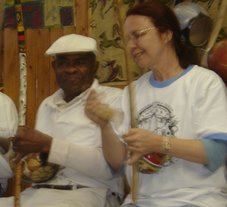
One thing set GCAP apart from the start: it was more than a Capoeira school. It was also a centre for the study of Capoeira Angola's history and the preservation of its living treasures, the "mestres antigos".
The training routine was rigorous. On Tuesdays and Thursdays, we would spend about 90 minutes practising moves and developing flexibility. Like most women, I had to work on my upper arm strength. Thanks to the GCAP method ("put one hand here, another there, and flip"), I finally learned to do an aú (in my case it was closer to a standard cartwheel than the slow, controlled Angoleiro style aú, which requires considerable arm strength and the ability to maintain a handstand).
Moraes told us that in Pastinha's school, landing with a thump was frowned on - particularly because it was on an upper floor and the people below complained. Even when the Mestre was old and blind, and probably deaf, he would catch offending "thumpers" and tell them to leave. I would have spent a lot of time in "detention" in those days.
Following the tradition of Pastinha's school, we wore black trousers and yellow t-shirts with the GCAP insignia. Trainers (sneakers) were also required - in direct contrast to the Regional "dress code" of bare feet, white baggy trousers and sometimes no shirts at all, for men.
Naturally, we also learned to play all the instruments in the Capoeira Angola "band": agogo (cowbells), recoreco (scraper), atabaque (conga drum), pandeiro (tambourine) and the Alto, Tenor and Bass berimbaus, called Rum, Rumpi and Lê, like their drum counterparts in Candomblé ceremonies.
Moraes and Cobrinha also taught us about the Angoleiro philosophy - which I found very similar to Zen thought - and encouraged us to learn about the history of our martial art. They emphasised its African roots, directly contradicting the Regional claim that Capoeira was created from scratch in Brazil, and traced its origins back to the Zebra Dance, or N'Golo, practised in what is now Angola.
They also organised "rodas de mestres antigos" to give the ageing masters of Pastinha's day a chance to show their stuff. They included some who have since passed away, like Mestre Waldemar (see photo above), as well as João Pequeno (whose school is still downstairs from GCAP in the Capoeira Fort), Curió, Mala, Boca Rica and many more - especially João Grande, of course.
Watching João Grande play was like observing a bout of chess, where hands and feet replace the pieces on the board. Mestre João can create and eliminate space, lay traps and set up his opponent as cleverly as any Russian grandmaster.
GCAP's Mestres, Contra-Mestre and top students, who then included Valmir (now Mestre at Fica in Salvador), Moraes's son Pepeu, Paulinha, Poloca, Janja and Zelias (my future ex-husband), would perform during public holidays, following a Capoeira tradition. One of the favourite dates is Bonfim Day.


No comments:
Post a Comment